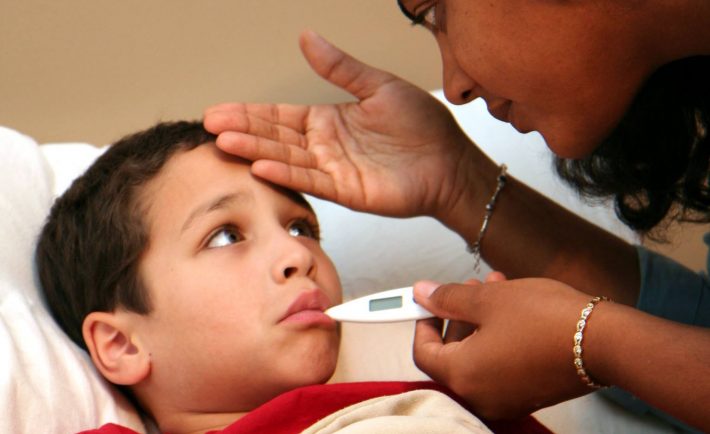Typhoid fever, or typhoid, is one of the world’s most common types of fever. It’s caused by the bacteria Salmonella Typhi and is typically spread through contaminated food or water or human contact with people with typhoid fever. This highly contagious disease causes flu-like symptoms and can be life-threatening if left untreated.
The good news is that doctors can treat typhoid fever, and most people recover after receiving antibiotics and other medical care. The following guide outlines everything you need to know about typhoid, including typhoid symptoms, tests, treatments, and more.
The Symptoms of Typhoid
Typhoid is an infectious disease that affects the intestinal tract. Symptoms include fever, constipation or diarrhea, rose-colored spots on the chest (called petechiae), swollen abdomen due to a build-up of abdominal fluid (ascites), pain when passing urine (dysuria), headaches, and muscle aches.
Typhoid symptoms usually start two weeks after exposure but can also appear within three days if it’s a more severe case.
Diagnosing Typhoid Fever
Since typhoids are mainly spread through ingestion of food or water that has been contaminated with fecal matter containing the bacterium Salmonella typhi, a doctor can make a diagnosis by taking samples from the patient’s feces or urine to detect if there is any bacteria present. If it’s detected, then they will start treatment with antibiotics to cure the disease.
Tests done for typhoid fever
A doctor will likely request a number of different tests if they suspect you have typhoid fever. These include a fecal examination (looking for the bacteria in your feces), looking for antibodies to H.pylori in your blood, and even looking at your stools under a microscope. These exams can help determine if you have contracted typhoid fever and its seriousness.
Complications of Typhoid
The most common typhoid fever complication is gallbladder inflammation (cholecystitis). Occasionally it can lead to a blockage in the gallblouse duct called gallstones. Other less frequent complications include inflammation of the lining of the abdominal cavity called peritonitis and rare cases that develop into a form of chronic arthritis.
There are no vaccines for typhoid, so prevention relies on good hygiene such as washing hands frequently, clean drinking water, safe food preparation, and avoiding raw vegetables like lettuce which may be contaminated with human or animal feces. A blood test will show if you have antibodies against Salmonella typhi, which would confirm the diagnosis of typhoid fever, but these tests are not always accurate.
Who is at risk of Typhoid?
Typhoid fever is transmitted via the ingestion of fecal matter from someone with the disease. People at higher risk for typhoidal infections include those in developing countries that have poor sewage systems or drinking water. Those traveling in regions where typhoid fever is common; or people living in close quarters with a person infected with typhoid fever.
Treatment Options for Typhoid Fever
There are two main treatments for typhoid fever. The first is a quinolone antibiotic, such as ciprofloxacin (Cipro) or levofloxacin (Levaquin). The second is chloramphenicol. Quinolones are usually given orally as capsules but can also be given intravenously or intramuscularly if you cannot take tablets by mouth. Chloramphenicol must be taken by mouth in tablet form.
Other treatments:
Drinking fluids: It’s important to drink plenty of fluids while ill with typhoid. The goal is at least 8 glasses of fluid daily, which will help prevent dehydration. Fluids should include water, juice, and other clear liquids that don’t contain alcohol or caffeine since these can make symptoms worse. Gatorade may be helpful since it provides some salt as well as potassium and other electrolytes that the body needs during illness.
Surgery: Some patients with complications from typhoid fever, such as perforated intestines or gallstones, need surgery. For example, gallstones may need to be removed if they block bile ducts and cause an infection of the gallbladder.
Prevention Methods
Typhoid fever is caused by bacteria called Salmonella typhi. The organism lives in the intestine of infected people or animals (most often mice and rats) without causing symptoms. When humans ingest food or water contaminated with feces containing S. typhi bacteria, they develop typhoid fever.
Antibiotics can cure the disease, but prevention is key. One way to avoid contracting typhoid fever is to get vaccinated for it. Another method is avoiding raw foods that have been grown in sewage-contaminated soil or sewage-contaminated water. Remember to wash your hands thoroughly before eating.
Conclusion
It’s important to be aware of the symptoms of typhoid, but the good news is that there are several tests available. The best treatment methods involve both taking antibiotics and drinking plenty of fluids. It’s important not to self-diagnose or delay in seeking treatment if you suspect you have typhoid fever. To ensure your safety and wellness, always see a doctor first before trying any treatments at home.
Read More Blogs:








